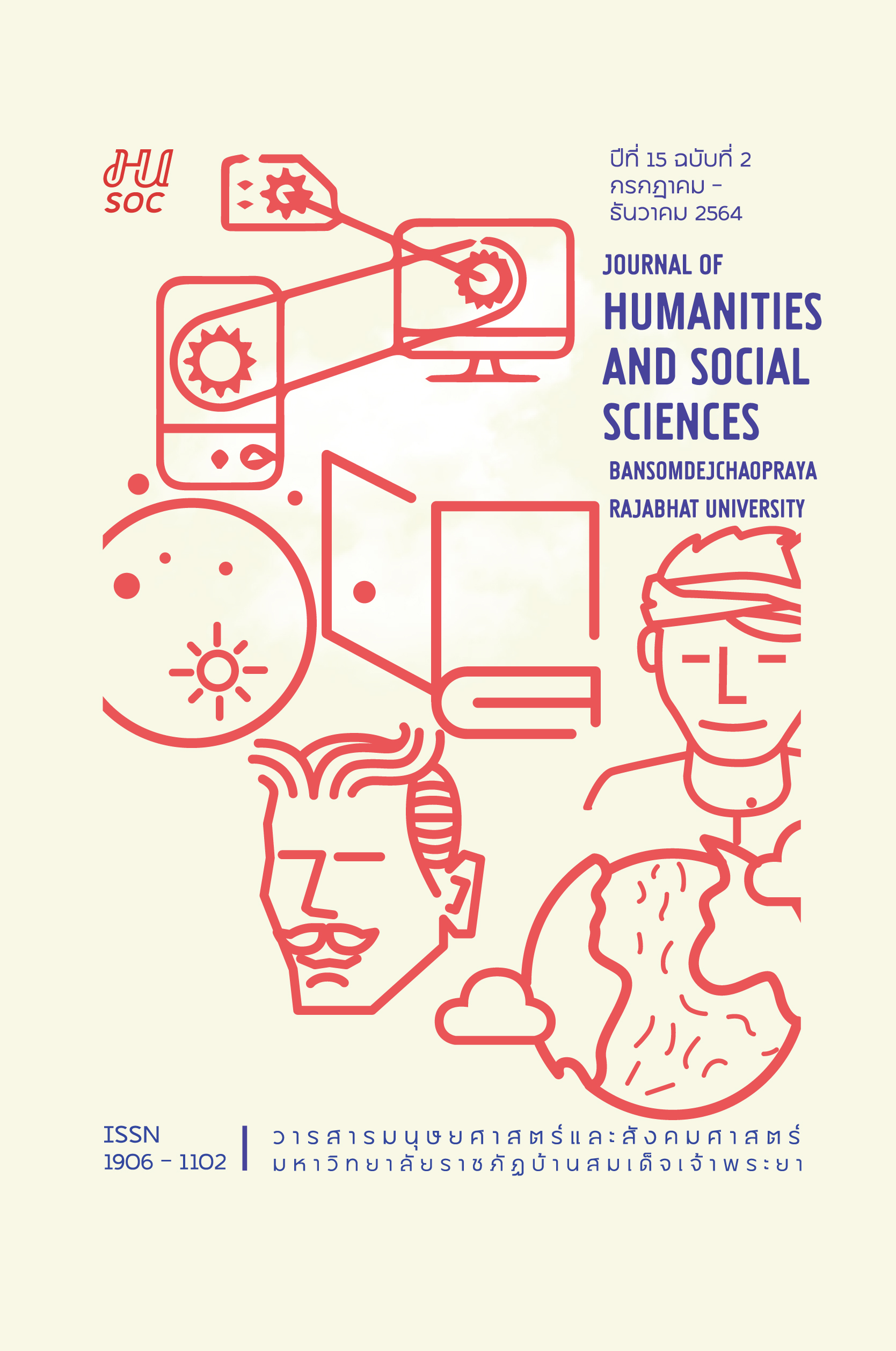The Process of Body Movement's Creation in The Case Study of Body of Illusion: The Creation of Body Movement from The Concept of Kaleidoscope
Keywords:
Illusion, Body Movement, KaleidoscopeAbstract
This research article is a part of Body of illusion:the creation of body movement from the concept of kaleidoscope. The objectives of this research are as follows: 1. to study
8 elements of creating body movement from the kaleidoscope-inspired; and 2. to create body movement performance through the kaleidoscope-inspired. This research article only presents the first objective.The research has been framed as a creative research using the creative research methology and drafting the research by analyzing related paperwork and media, improving and experimenting the 8 elements 3 times, assembling the artworks, collecting data, proposing the performance, concluding and estimating the result, creating paperwork, and publishing research papers respectively.The findings from the study on performance design by analyzing the 8 elements are: 1. The actor's body movement was conducted by keywords such as line, shapes, balance,symmetric and reflection which were experienced through the media webcam. 2. Other than being hand props, a big white flag and anti-sun could be applied as a projecting screen. 3. The story in the performance was sorted into 3 parts, namely illusion, dimension and back to the beginning. These 3 states occurred from visual stimuli of the researcher's points of view through a webcam. 4. Try out progress was used in order to find a soloist regardless of gender and age, who could react to the music,express the feeling of the story and using hand props, spontaneously bring the thought that he is being an untrained dancer, which was defined by a postmodern choreographer. 5. The postmodern music of Philip Glass was used in the performance. His music possesses the senses of harmony and conflict at the same time. It didn't use to direct the rhythm but to hold the surrounding atmosphere of the performance. 6. Dark colored costumes (black and silver) were used which enhanced the body movement and prevented the actor from sinking in the rays of the projector.The style of the costume is simple and it needs to allow movement.7. The stage with a proscenium arch enhanced the audience's focus and performing elements. 8. The main lighting in the performance came from the projector but in the last part,the light intensity was shared; 80% from the projector and another 20% from the side and down the stage light; to avoid each light source from getting disturbed.Debating the result of this study, the quantitative experiment may not be the accurate answer of the creative research because this study was experimented only 3 times. It's assumed to set the direct-point objective and clear goal in each experiment. Another thing is present days performances should be designed for flexibilily to be able to be showcased anywhere. Combining some of the 8 elements together yet still remains their important function.
References
ชาญณรงค์ พรรุ่งโรจน์. (2543). การวิจัยทางศิลปะ. กรุงเทพฯ: สำนักพิมพ์แห่งจุฬาลงกรณ์มหาวิทยาลัย.
ดาริณี ชํานาญหมอ. รองผู้อำนวยการฝ่ายวิชาการและวิจัย. (สัมภาษณ์, 10 เมษายน 2561).
ทีมงานเนชั่นทีวี. (2560). จินตนาการสำคัญกว่าความรู้. สืบค้น 22 มีนาคม 2561, จาก https://Www.Nationtv.Tv/Lifestyle/378551072
ธรากร จันทนะสาโร. (2557). นาฏยศิลป์จากแนวคิดไตรลักษณ์ในพระพุทธศาสนา. [วิทยานิพนธ์ศิลปกรรมศาสตรดุษฎีบัณฑิต. จุฬาลงกรณ์มหาวิทยาลัย].
นราพงษ์ จรัสศรี. (2548). ประวัตินาฏยศิลป์ตะวันตก. กรุงเทพฯ: โรงพิมพ์แห่งจุฬาลงกรณ์มหาวิทยาลัย.
รักษ์สินี อัครศวะเมฆ. (2557). นาฏยศิลป์สสร้างสรรค์สำหรับการแข่งขันยิมนาสติกลีลาในระดับนานาชาติ. [วิทยานิพนธ์ศิลปกรรมศาสตรดุษฎีบัณฑิต. จุฬาลงกรณ์มหาวิทยาลัย].
ศิริมงคล นาฏยกุล. (2551). นาฏยศิลป์หลักกายวิภาคและการเคลื่อนไหว. กรุงเทพฯ: โอเดียนสโตร์.
สทาศัย พงศ์หิรัญ. (2557). ดรสา แบหลา: นาฏยศิลป์สร้างสรรค์ จากวรรณคดีไทยเรื่อง อิเหนา. [วิทยานิพนธ์ศิลปกรรมศาสตรดุษฎีบัณฑิต. จุฬาลงกรณ์มหาวิทยาลัย].
สิริธร ศรีชลาคม. (2561, กรกฎาคม-ธันวาคม). ความเกี่ยวเนื่องของบัลเลต์และคณิตศาสตร์. วารสารศิลปกรรมศาสตร์ จุฬาลงกรณ์มหาวิทยาลัย, 5(2), 113-123.
Blom, L. A, & L. T. C. (1982). The Intimate Act of Choreography. London: University Of Pittsburgh Press.
M.S.Cerny. (2018). Choreography: A Basic Approach Using Improvisation. (4th Ed.). London: Human Kinetics.
Smith, J. M. (1985). Dance Composition A Practical Guide for Teacher. (2nd Ed.). London: A&C Black.
ธนะพัฒน์ พัฒน์กุลพิศาล.(2561). แสดงผลของภาพโครงสร้างวัตถุรูปทรงเรขาคณิต(Geometric Shapes). [ภาพถ่าย]. กรุงเทพฯ: สาขาวิชาศิลปะการแสดง คณะศิลปกรรมศาสตร์ มหาวิทยาลัยศรีนครินทรวิโรฒ.
ธนะพัฒน์ พัฒน์กุลพิศาล. (2561). แสดงผลการทดลององค์ประกอบด้านอุปกรณ์การแสดง[ภาพถ่าย]. กรุงเทพฯ: สาขาวิชาศิลปะการแสดง คณะศิลปกรรมศาสตร์ มหาวิทยาลัยศรีนครินทรวิโรฒ.
ธนะพัฒน์ พัฒน์กุลพิศาล. (2561). แสดงผลการทดลององค์ประกอบด้านเครื่องแต่งกาย.[ภาพถ่าย]. กรุงเทพฯ: สาขาวิชาศิลปะการแสดง คณะศิลปกรรมศาสตร์ มหาวิทยาลัยศรีนครินทรวิโรฒ.
ธนะพัฒน์ พัฒน์กุลพิศาล. (2561). ประมวลภาพการแสดง “ร่างลวง”. [ภาพถ่าย]. กรุงเทพฯ: สาขาวิชาศิลปะการแสดง คณะศิลปกรรมศาสตร์ มหาวิทยาลัยศรีนครินทรวิโรฒ.
ธรากร จันทนะสาโร. (2557). นาฏยศิลป์จากแนวคิดไตรลักษณ์ในพระพุทธศาสนา. [วิทยานิพนธ์ศิลปกรรมศาสตรดุษฎีบัณฑิต. จุฬาลงกรณ์มหาวิทยาลัย].
Downloads
Published
How to Cite
Issue
Section
License

This work is licensed under a Creative Commons Attribution-NonCommercial-NoDerivatives 4.0 International License.




